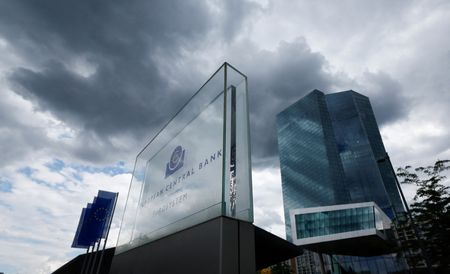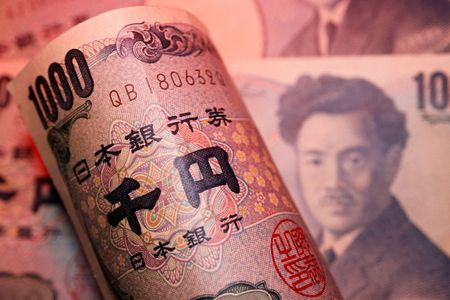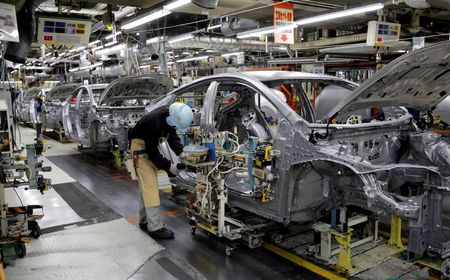By Balazs Koranyi and John Revill
FRANKFURT/ZURICH (Reuters) – Central banks around the globe have plenty of room to keep cutting interest rates, and a limited “decoupling” from the U.S. Federal Reserve could continue as it pauses its own policy easing, according to policymakers and analysts.
Such a parting of the ways could cause problems for U.S. President Donald Trump, taking the sting out of his planned tariffs on trade and even raising the risk that U.S. companies and households will have to pay more to borrow.
The Fed is the world’s biggest central bank and usually leads others in setting the direction for policy. But the start of 2025 has been far from normal.
The United States is in robust economic health while many of the world’s other large economies are struggling, which combined with the uncertainty caused by Trump’s policies and threats to trade is tying the Fed’s hands on further rate cuts.
The irony is that the global economy’s adjustment to a threatened trade war is undoing some of the intent of Trump’s tariffs even before they go into effect, to the benefit of foreign companies that sell to U.S. customers.
Tariffs boost inflation at home, so the Fed is keeping interest rates high. This is strengthening the dollar at the expense of most currencies, making it more lucrative to export to the United States, contrary to what the administration wants.
Switzerland, for example, is already enjoying a windfall.
“A weaker franc would also help Swiss industry by making exports to the U.S. cheaper,” said Karsten Junius, chief economist at J.Safra Sarasin. “This could also offset the impact of any U.S. tariffs imposed.”
The 20-nation euro zone, a key target of Trump’s rhetoric because of its large trade surplus, could also offset some of the punitive charge via a currency that has weakened by 7% since early autumn.
“European companies, in order to defend their market share, might be willing to sacrifice a bit of their margin,” European Central Bank board member Piero Cipollone said. “Part of this sacrifice might be recovered through the exchange rate. So, in the end, the overall impact may not be that big.”
A weak currency is usually inflationary because it makes imports, particularly energy, more expensive. But inflation is heading down in many places, due not least to weak growth caused by trade frictions, and policymakers do not seem bothered by developments so far.
The ECB, the Bank of England, and the Bank of Canada have all cut interest rates in recent days even after the Fed said it was not in a hurry to move. The Reserve Bank of India and the Bank of Mexico, though coming from higher levels, also cut rates overnight.
Tiff Macklem, Canada’s central bank chief, said the currency impact of differential interest rates had been “relatively modest” while the BoE said sterling’s fall – a 7% decline against the dollar since September – was small.
“We went from $1.12 (per euro last year) to $1.01 on Monday. Is it really changing the world for the ECB or for a central bank? I don’t think so,” Amundi’s head of global FX Andreas Koenig said.
LIMITS
There are signs that Trump, who only weeks ago was urging the Fed to cut, has recalibrated his view of where U.S. interest rates need to be.
Treasury Secretary Scott Bessent said this week that when Trump speaks of wanting lower rates, he is referring to the yield on 10-year Treasury notes – key to determining borrowing rates in the U.S. mortgage market and bank lending to businesses – rather than the short-term rate set by the central bank.
Policy divergence is also driven by economic fundamentals: the U.S. economy is simply doing better, so it will take a higher interest rate to extinguish undue inflationary pressures.
The interest rate gap cannot grow indefinitely, however.
“What worries central banks … is when you see significant currency weakness that feeds into a bond market selloff that feeds into further currency weakness and into inflation,” Dominic Bunning, global forex strategist at Nomura, said.
“You know that spiral – that’s what ultimately central banks would need to really deal with. But I don’t think you’re going to see that,” Bunning added.
Policymakers may also flinch if energy prices spike again, which could cause a double inflation hit as oil and gas are usually sold in dollars.
Another issue is that central banks can push down short-term interest rates but borrowing costs further out are driven by the market and if U.S. yields rise, others are likely to follow.
That makes borrowing more expensive and weakens economic growth.
“Normally if U.S. yields go up or down, European bonds go in the same direction,” GianLuigi Mandruzzato, senior economist at EFG Bank said. “Companies and households would face higher borrowing costs, despite short term interest rates being reduced by central banks.”
(Additional reporting by Francesco Canepa, Promit Mukherjee, Yoruk Bahceli, Marc Jones and Howard Schneider; Editing by Mark John and Catherine Evans)









